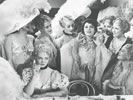Eye For Film >> Movies >> The Great Ziegfeld (1936) Film Review
The first part of the 20th century was a time when anything seemed possible. Artists feeling free to dream. Isadora Duncan transforming classical dance as an expression of the soul. Stanislavski and Method Acting revolutionising performance with a quest for emotional truth. Gordon Craig liberating stage design with elaborate movable screens and symbolic props. Greatness challenging universal paradigms and even the smallest of men able to reach for the stars. Cinema had barely been invented. But one person's excursion into theatrical revues launched a whole canon of movies. Florenz Ziegfeld Jr saw the Folies Bergères in Paris. From there he was inspired. He would glorify the all-American girl as she has never been glorified before or since. Glamour could become wholesome. And Broadway could scale new heights of extravagance.
It was said, "His theatrical genius lay in transforming popular but plebeian dramatic forms into art without losing their mass appeal." He noticed that his dancers 'walked better' wearing expensive Irish linen rather than plain cotton. As stage sets neared completion, he would visualise new heights. Incredibly successful, they were also incredibly expensive. He repeatedly went broke for his art.

The Great Ziegfeld is both a biopic and an attempt to show the wonder of the Ziegfeld Follies to a wider audience. Not everyone could afford the outrageous prices for the stage shows. In a similar vein, it cost a small fortune to produce. Much of the film is awful. But two things make it stand out, earning its celebrated place in the starry firmament. The first is the Oscar-winning performance of Luise Rainer (the film also won Best Picture and Best Dance Direction). The second is a long scene towards the end of the first half. After a long build-up, with shambolic dialogue and an uncharismatic actor playing Ziegfeld, we are treated to a cinematic recreation of the Follies. This exceeds expectation and takes the breath away.
The film follows Ziegfeld's life from 1893 at the 'World Fair' in Chicago. By the time he gets to Broadway he has a vision. "A girl is like a beautiful view." This is soon immortalised in an Irving Berlin song called A Pretty Girl Is Like A Melody. But if Ziegfeld objectifies the pretty girl to a male gaze, he does so by making her a goddess. Into his vision is built romance, champagne, the good life, and complex sets of unimaginable beauty. Popular choreography is interwoven with classical ballet. That one song involves 180 performers and 4,300 yards of rayon silk for the curtains, and ran up a cost of $220,000 (more than a whole stage show of the Follies). Yet it is one of the most wondrous scenes ever filmed. The archetype of 'A Pretty Girl' forms not only the apex of every man's desire, but the aspiration of every girl's heart. (The gender stereotyping, possibly offensive to some people now, is perhaps more a result of the conventions of the day than an expression of the artistic intentions of Ziegfeld.)
The elaborate choreography of the Follies, demonstrated to perfection in The Great Ziegfeld, spawned not only countless movies of kaleidoscopic legwork but a whole sub-industry around Hollywood. Producing a film such as this now would be difficult if not impossible. The age of the lavish song and dance film has disappeared, and with it the networked studio facilities of hundreds of dancers on call at any one moment. The Great Ziegfeld is a time capsule. Savour it well.
Reviewed on: 02 Jun 2008



















